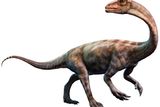Science
Ancient Fossil Discovery in Argentina Reveals New Dinosaur Species

A remarkable discovery in Argentina has unveiled a new species of dinosaur, identified as Huayracursor jaguensis, which is estimated to be around 230 million years old. This significant find was made in the foothills of the Andes Mountains in the province of La Rioja. Researchers from the National Scientific and Technical Research Council (CONICET) announced the details of the find in a study published in the journal Nature.
The fossil, notable for its incomplete nature as it lacks a head, is categorized as an early sauropodomorph, a precursor to the long-necked herbivorous dinosaurs that would later dominate the Mesozoic era. The specimen measures approximately 2 meters in length and weighs around 40 pounds, making it larger than many of its contemporaries, such as the Bagualasaurs that roamed Argentina during the same period.
Significance of the Discovery
Researchers believe that Huayracursor represents a crucial evolutionary step for sauropodomorphs. According to Martín Hechenleitner, a researcher at CONICET, “Huayracursor is novel because it exhibits two key features: a considerably longer neck and a larger size than most of its contemporaries.” This finding suggests that the characteristics associated with later sauropods appeared much earlier than previously understood.
The discovery was made possible by the recovery of an almost complete skeleton, including vertebrae, forelimbs, hindlimbs, and some cranial elements. Such completeness is rare and allows scientists to gain deeper insights into the anatomical features of early dinosaurs.
Exploring Uncharted Territories
The research team, led by Agustín Martinelli, has been exploring a previously uncharted region of La Rioja, where challenging terrain and adverse weather conditions had deterred previous scientific expeditions. Over the past decade, this area has proven to be a treasure trove of Triassic fauna.
“This new region, within a virtually unexplored geological basin, opens up the prospect of major discoveries,” Martinelli stated. The team has found not only the new dinosaur species but also a variety of other Triassic fossils, indicating the richness of this geological area.
The name Huayracursor reflects its origins; it is derived from the local high winds, while jaguensis pays homage to the nearby village of Jagué, where the fossil was unearthed. This naming convention highlights the connection between the discovery and its geographic context.
Looking ahead, the research team aims to expand their exploration further into the Andes. Sebastián Rocher, another author of the study, noted that stratigraphic and sedimentological studies have revealed that the Triassic terrains in the Northern Precordillera represent a sedimentary basin that developed independently from others in southwestern Gondwana. This opens the door for future expeditions that could yield even more significant finds.
The discovery of Huayracursor jaguensis not only enriches the narrative of dinosaur evolution but also emphasizes the importance of continued exploration in remote regions. As paleontologists delve deeper into the past, they uncover insights that reshape our understanding of the history of life on Earth.
-

 Business4 days ago
Business4 days agoInvestors Eye Potential $60,000 Gains with Ozak AI Token
-

 Politics5 days ago
Politics5 days agoFormer Pastor Arrested on Human Trafficking and Indecent Charges
-

 Business5 days ago
Business5 days agoQuotient Wealth Partners Adjusts Holdings in iShares Russell 1000 ETF
-

 Lifestyle5 days ago
Lifestyle5 days agoNatty from KISS OF LIFE Stuns in Micro-Shorts at Seoul Event
-

 Politics4 days ago
Politics4 days agoSkip Bayless Critiques Travis Hunter’s Game Day Baptism
-

 Entertainment5 days ago
Entertainment5 days agoUtah Residents Face Resource Shortages Amid Ongoing Government Shutdown
-

 Business5 days ago
Business5 days agoCalifornia to Ban All Plastic Bags in Grocery Stores by 2026
-

 Entertainment5 days ago
Entertainment5 days agoPete Davidson Surprises Pregnant Girlfriend with Private Jet to Concert
-

 Entertainment5 days ago
Entertainment5 days agoAce Frehley, KISS Guitarist, Passes Away at 74 After Fall
-

 Science5 days ago
Science5 days agoCommunity Mourns Loss of Judith Ernst, Pioneer Educator at 81
-

 Politics5 days ago
Politics5 days agoIberia Parish Sees Surge in Marriage Licenses Issued in October
-

 Science5 days ago
Science5 days agoMIT Develops Groundbreaking 3D Brain Models for Personalized Therapies









